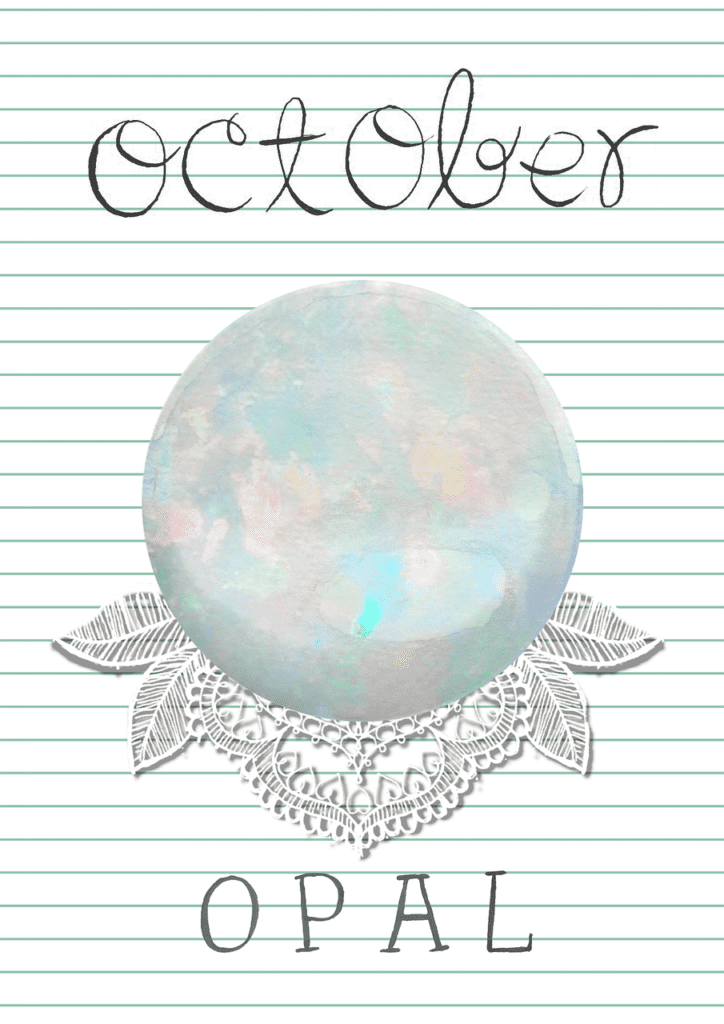Back to: The Magic of Birthstones MB1
Opal
Opal is in a class of it’s own f. As a species, opal is so unique its patterns have their own descriptive vocabulary. More than any other gem, each opal is distinctly individual. Opals are also the most delicate gemstones commonly worn and require special care.

Symbolism
Perhaps due to their dynamic appearance, opals are associated with light and magic. As such, some credited opals with healing properties, especially for the eyes. Some believed that opals could even make the wearer invisible. While some cling to negative superstitions about opals, others wear them for good luck.
Colour
Some opals can display the phenomenon known as play-of-colour, dazzling flashes of colour that move as the stone is turned. Opals are the only gems that can show this effect, but not all opals do.
WHERE IS OPAL FOUND?
The opal birthstone can be found in many places. The fields of Australia are the most productive in the world for the October birthstone. Ethiopia, Mexico and Brazil are also important sources. Additional deposits have been found in Central Europe, Honduras, Indonesia, Madagascar, Peru, Turkey and the United States.
Lightning Ridge, a small town in New South Wales, Australia, is famed for producing prized black opal. A dry and rocky region softened only by small trees and scrub brush, Lightning Ridge gets little rain and bakes in the scorching summer temperatures. The climate is so unforgiving that miners often live underground to find respite from the punishing heat.
Australia is also a source of other types of the October birthstone. White opal is found in the White Cliffs area of New South Wales, as well as in Mintabie, Andamooka and Coober Pedy in South Australia. Boulder opal, which comes from only one location in the world, is mined in Queensland.
Querétero, a state in Mexico, is known for producing fire opal in yellow, orange and reddish orange to red, some with good play-of-color. The mines are a tourist destination, and getting to them requires taking a dirt road through dense forests of pine and oak, past scrubby plateaus of cacti and shrubs, and up winding mountain roads.
OPAL BIRTHSTONE CARE & CLEANING
Opal may be treated by impregnation with oil, wax or plastic. Opal doublets or triplets are fine slices of opal glued to a base material and covered with a thin dome of clear quartz. The safest way to clean this October birthstone is with warm, soapy water. Other cleaning methods might damage the opal or filler material. Note that prolonged exposure to water may weaken the adhesive in opal doublets and triplets. Even natural opal can fracture if exposed to high heat or sudden temperature changes.
This October birthstone ranges from 5 to 6.5 on the Mohs scale of hardness. To prevent jewellery set with harder gems from scratching opal, store it by itself. Diamonds, rubies, sapphires, and emeralds are just a few of the gems that can scratch the October birthstone.
Tourmaline
No other gem comes in as many colors, including multi-colors, as tourmaline, the modern October birthstone. Some of these color combinations are incredible.
Symbolism
Tourmalines enjoy worldwide popularity. Some people believe tourmalines have healing and stress relieving properties. Tourmalines have also been credited with boosting creativity and are favored by artists and writers. Others wear them to soothe a broken heart.
Colour
Tourmalines occur naturally in a wide range of colours. Some of these colour varieties are known by trade names. Dark pink to red tourmalines are called “rubellites.” Neon-blue tourmalines known as “paraíbas” are highly prized. Unlike most other birthstones, tourmalines can even show zones of different colours in a single gem, like striking “watermelon tourmalines” with red, white, and green areas.
WHERE IS TOURMALINE FOUND?
This October birthstone is most commonly found in Brazil, but it is also mined in Afghanistan, Pakistan, Kenya, Madagascar and Mozambique (among other countries in Africa). California and Maine are historically important producers of fine tourmaline in the United States.
Most of the tourmaline mined in Brazil over the centuries comes from pegmatites in the state of Minas Gerais. These subterranean intrusions of magma are the source of a virtual kaleidoscope of gem minerals. In the late 1980s, however, electric green, blue and violet tourmalines entered the gem market from pegmatites in Brazil’s Paraíba State. Scientists found that the intense colors were caused by trace amounts of copper, which had previously not been recorded as a colouring agent in any other tourmaline. In the early 2000s, Paraíba-type copper-bearing tourmalines were also discovered in Mozambique and Nigeria. Overall, prices for the best Paraíba and Paraíba-type tourmalines easily surpass other tourmalines due to their vivid hues, higher colour saturation and greater rarity.
TOURMALINE BIRTHSTONE CARE & CLEANING
The tourmaline birthstone is rated 7 to 7.5 on the Mohs scale of hardness and is generally suitable for everyday wear. These colourful gems are usually stable enough to withstand light and most chemicals, but heat can be damaging. This October birthstone is best cleaned with warm, soapy water and a soft brush The use of ultrasonic and steam cleaners is not recommended.